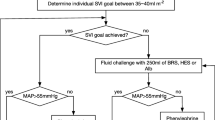Abstract
Background
Many studies have demonstrated the adverse consequences of pneumoperitoneum. However, few studies have examined the physiologic effects of pneumoperitoneum in adults with sickle cell disease (SCD) during laparoscopic cholecystectomy (LC).
Methods
60 ASA 1-П П patients, with cholelithiasis, scheduled for elective LC were allocated into two equal groups: group 1, normal patients without SCD (control group), and group 2, patients with SCD. The perioperative parameters of 30 SCD patients matched by age and sex to the 30 members of the non-sickler control group who underwent cholecystectomy were assessed. Study parameters (in the two groups) included heart rate (HR) per minute, mean blood pressure (MAP, mmHg), PETCO2, and O2 saturation (SpO2) at the following intervals: before induction of anesthesia in the supine position (all except PETCO2), after anesthesia and before CO2 insufflations in the supine position, 15, 30, 45, 60 min after CO2 insufflations in the anti-Trendelenburg position, at the end of CO2 exsufflation in the supine position and 5 min after the end of CO2 exsufflation in the supine position. Arterial blood gases, to measure pH, PaCO2, and PaO2, were determined after induction of anesthesia and before CO2 insufflation in the supine position, then 30 min after CO2 insufflations in the anti-Trendelenburg position, and 5 min after the end of CO2 exsufflation in the supine position. Statistical significance was established at the p < 0.05 level.
Results
Induction of anesthesia produced a significant increase in HR in both groups. CO2 insufflations led to an additional increase in HR and persisted till abdominal deflation. After CO2 insufflations, MAP significantly increased from the baseline at 15, 30, 45, and 60 min, and just before deflation in the anti-Trendelenburg position. CO2 insufflations led to a significant increase in end-tidal CO2 (ETCO2) in the study groups, reaching a maximum level just before abdominal deflation in the anti-Trendelenburg position. Regarding SpO2 and PaO2, there were insignificant changes in the two study groups throughout the procedure. In group 2, none of the patients experienced vaso-occlusive crises or other SCD- related complications.
Conclusion
This study proved the safety of LC in patients with SCD and cholelithiasis, and that they can tolerate the physiological effects of pneumoperitoneum as non-SCD adults.
Similar content being viewed by others
References
Rennels MB, Dunne MG, Grossman NJ, Schwartz AD (1984) Cholelithiasis in patients with major sickle hemoglobinopathies. Am J Dis Child 138:66–67
Koshy M, Weiner SJ, Miller ST, Sleeper LA, Vichinsky E, Brown AK, Khakoo Y, Kinney TR (1995) Surgery and anesthesia in sickle cell disease. Co-operative Study of Sickle Cell Diseases. Blood 86:3676–3684
Haberkern CM, Neumayr LD, Orringer EP, Earles AN, Robertson SM, Black D, Abboud MR, Koshy M, Idowu O, Vichinsky EP (1997) Cholecystectomy in sickle cell anemia patients: perioperative outcome of 364 cases from the National Preoperative Transfusion Study. Preoperative Transfusion in Sickle Cell Disease Study Group. Blood 89:1533–1542
David B, Rocco O (1994) physiologic effects of pneumoperitoneum. Am J Surg 167: 281–286
Carey P D, Kini US (2000) Laparoscopic surgery: the altered physiological response. J Ir Coll Phys Surg 29(2):96–105
Salama MM, Mallouh AA, Hamdan JA (1989) Acute splenic sequestration crises in Saudi children with sickle cell anemia. Ann Trop Ped 9:115–117
Al-mulhim AR, Al-mulhim FM, Al-suwaiygh AA (2002) The role of laparoscopic cholecystectomy in the management of acute cholecystitis in patients with sickle cell disease. Am J Surg 183:668–672
Meininger D, Byhahn C, Bueck M, et al. (2002) Effects of prolonged pneumoperitoneum on hemodynamics and acid-base balance during totally endoscopic robot-assisted radical prostatectomies. World J Surg 26:1423–1427
Fried M, Krska Z, Danzig V (2001) Does the laparoscopic approach significantly affect cardiac functions in laparoscopic surgery? Pilot study in non-obese and morbidly obese patients. Obes Surg 11:293–296
Cunningham AJ (1994) Laparoscopic surgery- Anaesthetic implication. Surg Endosc 8:1272–1284
Safran D, Sgambati S, Orlando R (1993) laparoscopy in high –risk cardiac patients. Surg Gynecol Obstet 176:548–554
Odeberg S, Lijungqvist O, Svenberg T, Gannedahl P, Von Rosen A, Sollevi A (1994) Hemodynamic effects of pneumopritoneum and the influence of posture during anesthesia for laparoscopic surgery. Acta Anesthesia Scand 38:276–283
Aoki T, Tanii M, Takahashi K, Tateda T, Miyajawa A (1994) Cardiovascular changes and plasma catecholamine levels during laparoscopic surgery. Anaesth Analg 78:S8
Felber A, Blobner M, Goelger S, Senekowitsch R, Jelen S (1993) Plasma vasopressin in laparoscopic cholecystectomy. Anesthesiology 79:A32
Joris J, Lamy M (1993) Neuroendocrine changes during pneumoperitoneum for laparoscopic cholecystectomy. Br J Anaesth 70:A33
Mealy K, Gallaher H, Barry M, Lennon F, Traynor O, Hyland J (1992) Physiological and metabolic responses to open and laparoscopic cholecystectomy. Br J Surg 79:1061–1064
Hudson J, Wurm WH, O’Donnell TF, et al. (1988) Hemodynamics and prostacycline release in the early phases of aortic surgery. Comparison of transabdominal and retroperitoneal approaches. J Vasc Surg 7:190–197
O’Malley C, Cunningham AJ (2001) Physiologic changes during laparoscopy. Anesthesiol Clin North Am 19:1–19
Zuckerman R, Gold M, Jenkins P, et al. (2001) The effects of pneumoperitoneum and patient position on hemodynamics during laparoscopic cholecystectomy. Surg Endosc 15:561–565
Nguyen NT, Anderson J, Fleming NW, et al. (2002) Effects of pneumoperitoneum on intraoperative respiratory mechanics and gas exchange during laparoscopic gastric bypass. Surg Endosc 16:78–83
Demiroluk S, Salihoglu Z, Zengin K, et al. (2002) The effects of pneumoperitoneum on respiratory mechanics during bariatric surgery. Obes Surg 12:376–379
Vichinsky EP, Haberkern CM, Neurnayt L, Earles AN, Black D, Koshy M, Iyer RV (1995) The Preoperative Transfusion Study Group: A comparison of conservative and aggressive transfusion regimens in the perioperative management of sickle cell disease. N Engl J Med 333:206–213
Tagge EP, Othersen HB, Jackson SM, Smith CD, Abboud MR, Adams DB (1994) Impact of laparoscopic cholecystectomy on the management of cholelithiasis in children with sickle cell disease. J Pediatr Surg 29:209–212
Author information
Authors and Affiliations
Corresponding author
Rights and permissions
About this article
Cite this article
Youssef, M.A.M., Mulhim, A.A. Physiologic effects of pneumoperitoneum in adults with sickle cell disease undergoing laparoscopic cholecystectomy (A case control study). Surg Endosc 22, 1513–1518 (2008). https://doi.org/10.1007/s00464-007-9624-y
Received:
Revised:
Accepted:
Published:
Issue Date:
DOI: https://doi.org/10.1007/s00464-007-9624-y




